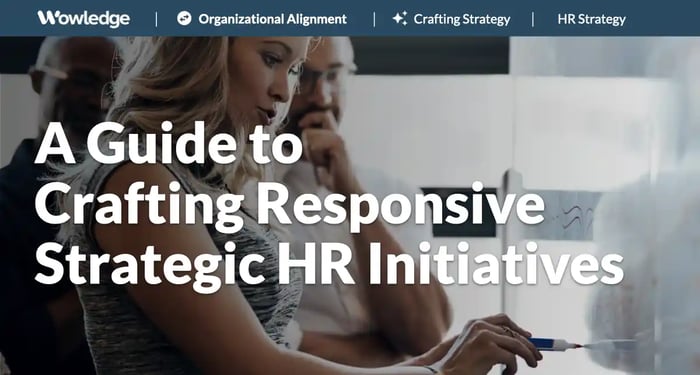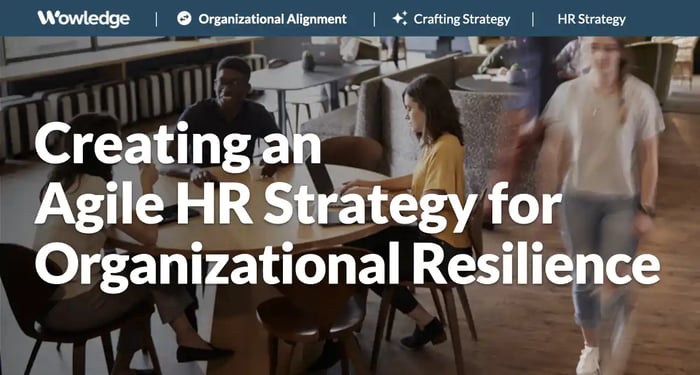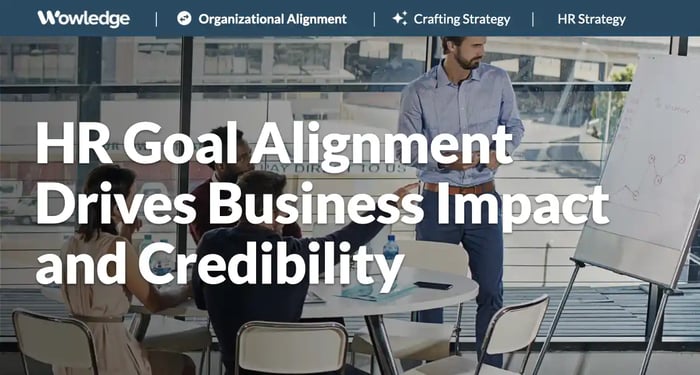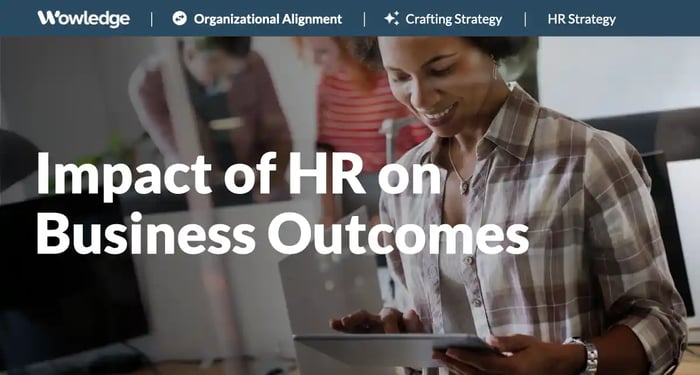Table of Contents
A significant number of elements in organizational and operational life and success are fluctuating substantially for companies globally, with significant disruptions having emerged on the economic, trade, labor market, public health, and technological fronts. While some of the trends in these can be written off as cyclical, others appear to be revolutionary and thus likely to continue to create instability for years to come. As these shifts and changes ebb and flow, the need for more agile and responsive strategic HR initiatives is creating tremendous pressure on HR leaders and their teams. Managing and countering that pressure requires proactive and thoughtfully planned approaches and comprehensively designed solutions that many HR teams will find difficult to accomplish. But a pathway to creating impactful HR strategic initiatives can be put in place regardless of the size and resources at an HR leader’s disposal.
Understanding the nature of high-impact strategic HR initiatives
Strategic HR initiatives are targeted HR projects that are designed to directly support and positively impact specified business, financial, and operational needs and objectives by leveraging human capabilities to achieve:
- Solutions to workforce problems: These represent talent-related issues that are inhibiting the achievement of strategic, operational, financial, and customer objectives. These are classic issues facing the organization, such as staffing shortages, resistance to change, skill gaps or obsolescence, management weaknesses, cost pressures, employee turnover, and leadership myopia or tunnel-vision.
- Development and deployment of human-based capabilities: These are precursors to, or direct drivers of, successfully meeting new or emerging business strategies, opportunities, and challenges. Examples include emerging or obsolescent skills, collaboration, innovation, digital and technological competency, learning agility, resourcefulness, and adaptability.
- Responses to external elements of the organizational ecosystem: These are challenges that require attention and modification to enable or support the adaptation to, or overcome, external barriers to success. Issues include those outside influences beyond direct control, arising from entries into new markets or industry segments, or changes in economic, regulatory, technological, socio-political, or environmental circumstances or conditions.
Key characteristics of strategic HR initiatives
Strategic HR initiatives differ from many projects and improvement efforts that are seen in HR leaders’ and senior contributors’ annual performance goals. They are, by nature, more expansive and targeted towards supporting the meeting of larger business, financial, or operational objectives. They are often differentiated by their being shared across multiple HR functions or departments, with unique contributions, timelines, and success measures or outcomes for each. Eight primary characteristics tend to describe these.
Transformative
Strategic HR initiatives take the organization somewhere new and novel. They leverage unique, innovative approaches that may be unfamiliar as HR methods and approaches. The initiative is designed to create new viewpoints, values, standards, cultural elements, and capabilities. They introduce new processes, procedures (methodologies), practices, programs, or platforms (technologies).
Transparently aligned with business goals
They are directly linked to and support the company's overarching vision and objectives, and are clearly stated as and designed to influence, enable, or drive specified business outcomes. They develop organizational capabilities necessary to make considerable progress toward one or more strategic objectives. They are articulated as specific, well-communicated objectives and outcomes that leaders and employees will understand.
Focused on the long-term
Strategic HR initiatives look beyond daily operational issues to address future challenges and opportunities, often with a two- to three-year outlook and a corresponding response development timeframe. They foresee opportunities and challenges that the business needs to address and develop a plan to evolve the organization’s capabilities to manage those effectively.
Planned with milestone achievements
Recognizing that organizational change can require time and continuity of effort to take hold, initiative plans often focus on building-block approaches that yield early wins with foundational changes, while progressively building on those to drive more gradual and “digestible” adoption of the changes as core values are lived by all employees.
Data-driven
Strategic HR initiatives rely on data and analytics to inform design, planning, and execution, ensuring greater certainty, effective risk management, and credibility with decision-makers and impacted employees alike. These are used to project and demonstrate the return on investment, more accurately identify root causes, understand employee sentiment that can be used or overcome to enhance adoption, and objectively evaluate the degree of success and impact that the changes are making.
Proactive and anticipatory
While some HR initiatives are necessarily responsive to urgent or dramatic events or changes, the need for strategic initiatives is typically identified in advance, by anticipating future trends and events. Strategic HR leverages internal and external expertise, research, and insights to anticipate and prevent problems by understanding how projected future issues might impact organizational direction and strategies.
Comprehensive and integrated
The most successful strategic initiatives integrate all relevant HR capabilities with the broader business strategy, positioning HR as a strategic partner. These bring together five core organizational elements to integrate and leverage a comprehensive use of people, processes, practices, places, and platforms.
Jointly governed and well-managed change
A crucial key to success lies in bringing business leaders into the planning and oversight of strategic HR initiatives. They are championed by a combination of leaders who are most influential and those whose teams will experience the most change or benefit from the transformation. As a result, change management approaches are embedded in project plans to engage key stakeholders as champions, design partners, and accountability partners.

Identifying strategic HR initiatives from an outcomes perspective
A unique aspect of identifying strategic responses to new business or operational directions or objectives is the need to view HR from an outcomes-based, rather than the traditional process-based (e.g., TA, L&D, Compensation) viewpoint. This brings integrated HR capabilities into play, which can represent a challenge for many siloed or fragmented HR functions. Consider the outcomes that many strategic HR initiatives are designed to influence or impact that require the combined input and expertise from HRBPs, COEs, and HR Shared Services to effectively design, develop, and execute improvements in:
- Employee productivity.
- Individual, team, and organizational performance.
- Leadership pool depth, breadth, and readiness.
- Employee engagement and mission alignment.
- Retention of experienced, acclimated, and enculturated employees.
- Managing talent pool volumes, skills, proficiency, and replacements in synch with business needs.
- Company culture and employee behavior alignment with business and customer needs.
- Employee resilience, agility, flexibility, adaptability, and cross-functional collaboration and integration.
In each of these examples, the perspective shifts from identifying a solution in response to “a (compensation, L&D, or recruiting) problem” to one that requires the deployment of “HR capabilities”. Along with that shift in mindset (and communication) is the need to position the strategic HR initiative as a response to overcoming a barrier or supporting a need related to achieving a future business strategy or goal, such as a planned digital transformation or new product/service/process innovation.
Examples of strategic HR initiatives
The range of strategic HR initiatives designed to impact and support larger-scale business and operational advances and improvements can be substantial and widely varied, and clearly place the HR leaders and their teams in the middle of strategic organizational transformations. The value they offer is expertise in human learning and adaptation, including how to identify and quantify the knowledge, skills, and expertise required to perform specific work tasks, as well as what the workforce needs from managers to optimally execute their work requirements. Examples of initiatives that HR can drive or support might include:
- Cultural and operational transformation related to enhanced innovation, product or service quality, operating expense management and control, and customer focus.
- Process redesign and streamlining methodologies, training, and execution for operational, HR, or administrative workflows.
- Organization redesign related to flattening or delayering, management team optimization, re-shoring, outsourcing, and new external partnerships.
- Accelerated upskilling and reskilling related to new product or service workflows, technology adoptions, leadership, and management development.
- Digital transformation planning and support for larger-scale AI and automation adoptions, robotization introductions, and customer and supplier systems enhancements and upgrades.
- Workforce resizing that is required as a result of a business efficiency push, or as a result of upstaffing or reductions in force needs based on economic growth or downturns.
Other smaller and more targeted HR initiatives might be based on identified operational or talent shortcomings in an underperforming business unit, function, or facility that requires HR’s leveraging of one or more of its many capabilities. Often identified and led by an HR business partner (HRBP), these HR initiatives are both strategic and outcome-based. Based on the three previously mentioned reasons for strategic HR initiatives, examples of these would include:
- Workforce problems. Targeted solutions related to making significant and lasting improvements in assessing functional skills and gaps, recruiting new skills, measuring and tracking critical skills employee sentiment, upgrading middle management job requirements, and introducing data-driven skills and tools in support of a functional or departmental cultural shift.
- Human-based capabilities development. Initiatives may involve targeted skills and knowledge development for specific teams or functions, formal mobility processes for expertise development and transfer, or organizational development interventions to enhance team performance and capabilities.
- External organizational ecosystem influences. Cultural change and refinement, continuous improvement, cross-functional partnerships, external awareness and relationships, and flexible and targeted organization design.

How to Develop Strategic HR Initiatives
The process of creating business-aligned, actionable, and impactful strategic HR initiatives requires a disciplined approach to understanding business direction and plans, collecting the right set of insights, engaging a cross-functional team of experts, and establishing plans that are directly tied to specified business and talent requirements. A leading practice is to develop a template and process that can be used and refined over time by HR leaders and subject matter experts (SMEs) for a consistent, and most crucially, comprehensive approach to identifying strategic HR initiatives that drive real improvement and change.
1. Analyze the business and external environment
Understand the organization's current situation, market, and future goals. Review strategic plans and then research the opinions of external academic, industry, and professional experts, as well as futurists, across a range of fields, including economic, functional, environmental, and governmental. The key is to develop a clear understanding of the changes and adaptations that the organization needs to prepare to meet its primary business goals and objectives.
2. Identify key internal challenges
Determine the most critical people-related challenges that could impede business success. Rely on talent data and reporting, as well as tailored predictive analyses, to identify future talent losses, skill gaps, and other shortcomings that may negatively impact the achievement of business and operational strategies, revenue and expense requirements, or shareholder expectations.
3. Develop a business case and generate leadership buy-in
Often overlooked is the development of a business case that clearly states the targeted issue, the associated risks and challenges the organization will face, the proposed solution, and the detailed plan. By articulating and quantifying the issue, how the strategic initiative aligns with business strategy, and a cost-benefit analysis of the proposed solution, a credible case can be presented to leadership to gain their support and approval. Start early and build support with key leaders and partners (e.g., Finance, IT) to generate alignment and agreement on the need and approach. The presentation should include a project plan(s), budget requirements, projected quantitative and qualitative benefits, and a change management strategy to support its successful implementation.
4. Identify key resources needed
Review the initiative plan to determine the expertise required, both within and outside the existing HR team. Discuss the shifting of HR experts from their normal duties to a part-time or full-time role as an initiative team leader or participant. Consider the need for external expertise, or that available from peer organizations, such as statistical and analysis support from marketing, finance, or an advanced analytics function. Make necessary plans for backfilling of critical roles during the initiative project timeline. Similarly, budgets need to be identified, and can be a result of “fresh” funding for the initiative, shifting from other existing allocations, and cost-sharing with peer organizations who will participate (e.g., IT) or benefit (e.g., targeted business units) from the output of the initiative.
5. Prioritize HR initiatives
Review all planned or in-process HR projects to understand the potential impact that the proposed initiative will have on the resources and budget, currently deployed or in use elsewhere. Understand the new one as it relates to HR staff deployments and workloads, project scheduling and timelines, budget and resource allocations, and logistics assigned to the combined priorities. Be prepared to shift priorities to focus on those with the highest potential impact and ROI for the organization.
6. Prepare for change
The inclusion of a formal strategic change management approach helps build understanding, support, acceptance, and implementation of the changes and improvements that result from strategic HR initiatives among leaders, managers, and employees. The ability to secure the buy-in and adoption of targeted end-users is one of two essential elements of success, after having a well-considered, designed, and executed introduction, upgrade, or improvement.
7. Monitor and adapt
A planned and formal review of the initiative’s progress against design, development, and implementation milestones, budget, and pilots is a crucial step in maintaining momentum and executive support. Similarly, having planned and periodic reviews of the effect and impact of the upgrades or changes allows for a continuous improvement and refinement approach that optimizes the design as business and operational circumstances and environments evolve. This requires the identification of process and outcome measurement and reporting that can be used to monitor how well it meets its purpose, assess its continuing value, and drive informed decision-making about actions needed to address issues, and adjust the strategy to remain relevant and effective.
Equally valuable is that measuring the impact of strategic HR initiatives provides ongoing justification for the original concept, as well as a jointly held success with business and peer function leaders. The greatest outcome, however, of conducting and performing these strategic HR initiatives so well is the credibility and trust that is gained in the HR team’s ability to understand future business-impacting trends, envision a future that leverages all of its capabilities, create a solid business case for changes, and execute with skill and effectiveness.
Relevant Practices & Tools
Emerging Change Management Practices to Grow the Company’s Change Capacity. >
The pace of change has grown exponentially. Information is now more readily available as technology advances and the lines between work and personal life blur... more »
Establishing an HR Organization that Drives the ‘Future of Work’ Across the Business. >
The "Future of Work" is a construct based on three major components - future or forthcoming changes in work method ("what" is done), the makeup of the worker population ("who does the work"), and the location of the workplace ("where the work is done")... more »
Gathering, Analyzing, and Actioning Change Management Data to Clarify Needs and Measure Impact. >
Understanding how effective a change management strategy is with different stakeholder groups enables better engagement and the opportunity to adjust activities to better relate with each group... more »
Applying Organization Development Principles to Uncover Opportunities for Improving Organizational Performance and Health. >
Organizations are constantly in flux, with multiple change efforts underway. HR is being called upon to facilitate more and more of these endeavors, using Organizational Development tools, methodologies, and frameworks... more »
The Behavioral Shifts to Drive Culture Tool: Determine and Communicate Expectations of Behavior Change and Cultural Alignment. >
This tool aids in determining and communicating expectations of behavior change and cultural alignment to new digital norms and ways of operating within the organization... more »
About Wowledge
Wowledge is the implementation-first platform designed for lean HR teams and consultants who need to design and scale strategic HR programs efficiently—without starting from scratch.
Our members gain access to continuously updated best practices, step-by-step guidance, expert-built tools, and customizable templates—all structured to accelerate the development and implementation of key HR programs.
Recognizing that every organization operates at different levels of sophistication, Wowledge’s scalable system of best practices follows a stage-based approach—Core, Advanced, and Emerging—ensuring HR professionals can implement solutions tailored to their organization’s unique needs and goals.
Your Shortcut to Amplifying HR Impact!
Get started for FREE! Learn more.










